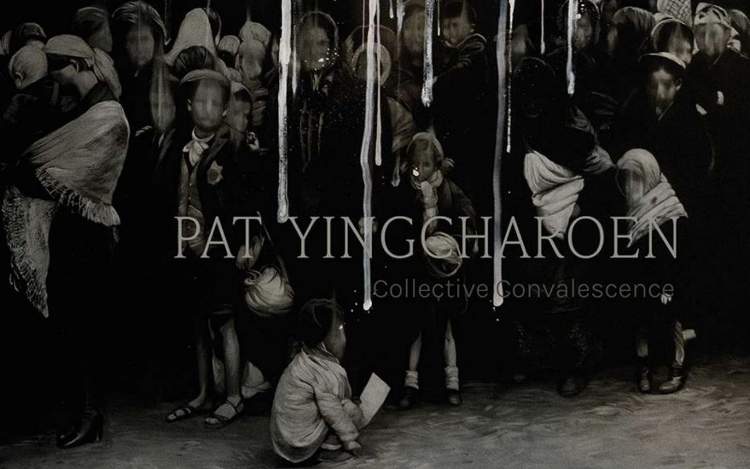
Collective Convalescence is the first monograph on the young Thai artist Pat Yingcharoen, whose paintings combine tragic images of violence from art history and photojournalism. The elegantly designed book features an essay by Panu Boonpipattanapong and an interview with the artist by Korn Karava. (Korn also edited and published the book, which is the second volume in a series that began with No God No King Only Human.)
Like many artists of his generation, Pat experienced a political awakening following the 2014 coup. It was this newfound awareness, known in Thai as ta sawang, which first led him to transition from “conducting painting experiments to focusing more on the historical aspects.” (Novelists Uthis Haemamool and Veeraporn Nitiprapha have also discussed their ta sawang experiences, and it was a recurring theme in interviews with film directors for Thai Cinema Uncensored.)
In particular, Pat often incorporates elements from photographs of the 6th October 1976 massacre, which he regards as “among the most iconic depictions of Thai history”. In his essay, Panu explains that these images of hanged and desecrated bodies are juxtaposed and decontextualised, so that “new dimensions of history that may have been previously suppressed are discovered.”
Images of the 1976 massacre are depicted prominently in several of Pat’s works. In Sacred Punishment, one of the victims is transposed into a reproduction of William-Adolphe Bouguerau’s Flagellation of Our Lord Jesus Christ (La flagellation de Notre-Seigneur Jésus-Christ). In Beater, Neal Ulevich’s infamous image of a man holding a folding chair is superimposed over a detail from the same Bouguerau painting. In Martyrs, another victim is placed in the centre of Andrea del Sarto’s Disputation on the Trinity (Disputa sulla Trinità).
The artist’s other visual references to the massacre are more subtle. Onlookers from the background of Ulevich’s photograph appear in Under the Blue Moon (shown at his Blue Rhapsody exhibition at Number One Gallery last year) and From Jesus to the Void. The distinctive tree trunk from which a victim was hanged in Ulevich’s picture appears in the backgrounds of Imaginary Horizon—a reproduction of Bouguerau’s First Mourning (Premier deuil)—and Cain and Abel. (Another young Thai artist, Pachara Piyasongsoot, also painted the same tree trunk, in The Garden.)
Pat Yingcharoen: Collective Convalescence was published last month, in an edition of 300 (mine being no. 294). Each copy is numbered and signed with a flourish by the artist. (Curiously, he spells his first name Patt, while the book uses an alternative English spelling, Pat.)
Like many artists of his generation, Pat experienced a political awakening following the 2014 coup. It was this newfound awareness, known in Thai as ta sawang, which first led him to transition from “conducting painting experiments to focusing more on the historical aspects.” (Novelists Uthis Haemamool and Veeraporn Nitiprapha have also discussed their ta sawang experiences, and it was a recurring theme in interviews with film directors for Thai Cinema Uncensored.)
In particular, Pat often incorporates elements from photographs of the 6th October 1976 massacre, which he regards as “among the most iconic depictions of Thai history”. In his essay, Panu explains that these images of hanged and desecrated bodies are juxtaposed and decontextualised, so that “new dimensions of history that may have been previously suppressed are discovered.”
Images of the 1976 massacre are depicted prominently in several of Pat’s works. In Sacred Punishment, one of the victims is transposed into a reproduction of William-Adolphe Bouguerau’s Flagellation of Our Lord Jesus Christ (La flagellation de Notre-Seigneur Jésus-Christ). In Beater, Neal Ulevich’s infamous image of a man holding a folding chair is superimposed over a detail from the same Bouguerau painting. In Martyrs, another victim is placed in the centre of Andrea del Sarto’s Disputation on the Trinity (Disputa sulla Trinità).
The artist’s other visual references to the massacre are more subtle. Onlookers from the background of Ulevich’s photograph appear in Under the Blue Moon (shown at his Blue Rhapsody exhibition at Number One Gallery last year) and From Jesus to the Void. The distinctive tree trunk from which a victim was hanged in Ulevich’s picture appears in the backgrounds of Imaginary Horizon—a reproduction of Bouguerau’s First Mourning (Premier deuil)—and Cain and Abel. (Another young Thai artist, Pachara Piyasongsoot, also painted the same tree trunk, in The Garden.)
Pat Yingcharoen: Collective Convalescence was published last month, in an edition of 300 (mine being no. 294). Each copy is numbered and signed with a flourish by the artist. (Curiously, he spells his first name Patt, while the book uses an alternative English spelling, Pat.)
